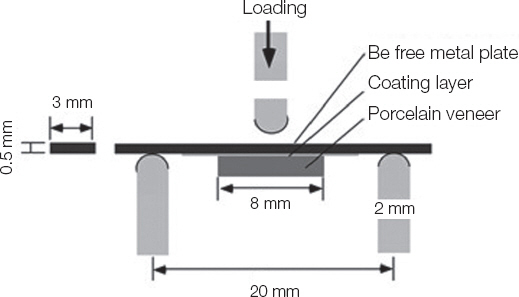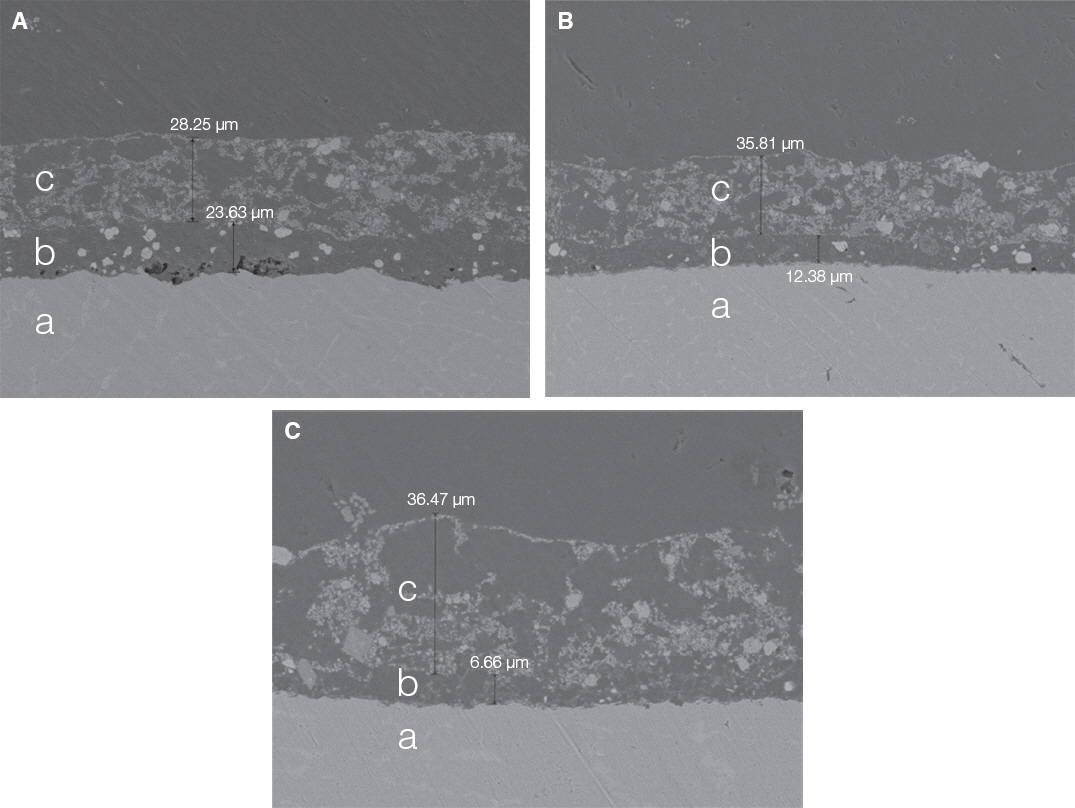J Dent Rehabil Appl Sci.
2017 Jun;33(2):71-79. 10.14368/jdras.2017.33.2.71.
Effect of titanium powder on the bond strength of metal heat treatment
- Affiliations
-
- 1Department of Dental Technology, Kyungdong University, Uijeongbu, Republic of Korea.
- 2Department of Dental Technology and Science, College of Health Science, Shin-Han University, Uijeongbu, Republic of Korea. wrdeul@hanmail.net
- KMID: 2388012
- DOI: http://doi.org/10.14368/jdras.2017.33.2.71
Abstract
- PURPOSE
Ni-Cr alloy does not contain Beryllium, causing the metal compound to form oxides in the furnace but by using Titanium as a chemical catalyst the forming of the oxides can be controlled, and by controlling the impurities formed on the metal surface, the possibility of the Ni-Cr alloy bond strength being increased can be analysed.
MATERIALS AND METHODS
Titanium was used as a chemical catalyst in the porcelain for the oxidation of beryllium-free metal (Ni-Cr) alloy. The T1 group, which does not use Titanium power as a chemical catalyst is a reference model for comparison. The T2 group and T3 group used 10 g and 20 g of Titanium power, respectively. They are fabricated to observe the shear bond strength and surface properties. There was no significance when One-way ANOVA analysis/Tukey Honestly Significant Difference Test was conducted for statistical analysis among groups (P > 0.05).
RESULTS
Results of measuring the three-point flexural bond strength of the Ni-Cr alloy and thickness of the oxide film. Experiment T3 using 20 g Titanium chemical catalyst: 39.22 ± 3.41 MPa and 6.66 µm, having the highest bond strength and thinness of oxide film. Experiment T2 using 10 g Titanium chemical catalyst: 34.65 ± 1.39 MPa and 13.22 µm. Experiment T1 using no Titanium chemical catalyst: 32.37 ± 1.91 MPa and 22.22 µm.
CONCLUSION
The T2 and T3 experiments using Titanium chemical catalyst showed higher bond strength for the Ni-Cr alloy and lower thickness of oxide film than experiment T1, and the titanium catalyst being able to increase bond strength was observed.
Keyword
MeSH Terms
Figure
Reference
-
References
1. Wataha JC, Messer RL. Casting alloys. Dent Clin North Am. 2004; 48:499–512. DOI: 10.1016/j.cden.2003.12.010. PMID: 15172613.2. McCabe JF, Walls AWG. Applied dental materials. 1994. 7th ed. London: Mass Publishing Co;p. 71–8.3. Oshida Y, Fung LW, Isikbay SC. Titanium-porcelain system. Part II:bond strength of fired porcelain on nitrided pure titanium. Biomed Mater Eng. 1997; 7:13–34.4. Cascone PJ, Massimo M, Tuccillo JJ. Theoretical interfacial reactions responsible for bonding in porcelainto-metal systems. Part II-Oxidation of alloys. J Dent Res. 1978; 57:872.5. Sakaguchi R, Powers J. Resin composite restorative materials. Craig’s restorative dental materials. 2006. 12th ed. St. Lousis: Mosby Elsevier;p. 189–212.6. Morris HF. Properties of cobalt-chromium metal ceramic alloys after heat treatment. J Prosthet Dent. 1990; 63:426–33. DOI: 10.1016/0022-3913(90)90232-2.7. Pierce LH, Goodkind RJ. A status report of possible risks of base metal alloys and their components. J Prosthet Dent. 1989; 62:234–8. DOI: 10.1016/0022-3913(89)90320-X.8. Magnusson B, Bergman M, Bergman B, Söremark R. Nickel allergy and nickel-containing dental alloys. Scand J Dent Res. 1982; 90:163–7. DOI: 10.1111/j.1600-0722.1982.tb01540.x.9. Wang RR, Welsch GE, Monteriro O. Silicon nitride coating on titanium to enable titanium-ceramic bonding. J Biomed Mater Res. 1999; 46:262–70. DOI: 10.1002/(SICI)1097-4636(199908)46:2<262::AID-JBM16>3.0.CO;2-1.10. Walter M, Reppel PD, Böning K, Freesmeyers WB. Six-year follow-up of titanium and high-gold porcelainfused-to metal fixed partial dentures. J Oral Rehabil. 1999; 26:91–6. DOI: 10.1046/j.1365-2842.1999.00373.x. PMID: 10080304.11. Kaus T, Pröbster L, Weber H. Clinical follow-up study of ceramic veneered titanium restorations three-year results. Int J Prosthodont. 1996; 9:9–15.12. Sandrock G, Gross K, Thomas G. Effect of Ticatalyst content on the reversible hydrogen storage properties of the sodium alanates. J Alloy Compd. 2002; 339:299–308. DOI: 10.1016/S0925-8388(01)02014-X.13. Matković T, Slokar L, Matković P. Structure and properties of biomedical Co-Cr-Ti alloys. J Alloy Compd. 2006; 407:294–8. DOI: 10.1016/j.jallcom.2005.06.025.14. Dent RJ, Preston JD, Moffa JP, Caputo A. Effect of oxidation on ceramometal bond strength. J Prosthet Dent. 1982; 47:59–62. DOI: 10.1016/0022-3913(82)90243-8.15. O’brien WJ, Seluk LW, Fan PL, Saunders DN. Classification of porcelain enamel interfacial fractures. J Dent Res. 1976; 55:506.16. Lenz J, Schwarz S, Schwickerath H, Sperner F, Schäfer A. Bond strength of metal-ceramic systems in three-point flexure bond test. J Appl Biomater. 1995; 6:55–64. DOI: 10.1002/jab.770060108. PMID: 7703538.17. Barghi N, Lorenzana RE. Optimum thickness of opaque and body porcelain. J Prosthet Dent. 1982; 48:429–31. DOI: 10.1016/0022-3913(82)90080-4.18. DeHoff PH, Anusavice KJ, Hathcock PW. An evaluation of the four point flexural test for metalceramic bond strength. J Dent Res. 1982; 61:1066–9. DOI: 10.1177/00220345820610090801. PMID: 6763043.19. Choi BK, Han JS, Yang JH, Lee JB, Kim SH. Shear bond strength of veneering porcelain to zirconia and metal cores. J Adv Prosthodont. 2009; 1:129–35. DOI: 10.4047/jap.2009.1.3.129. PMID: 21165268. PMCID: PMC2994690.20. Kelly JR, Rose TC. Nonprecious alloys for use in fixed prosthodontics:a literature review. J Prosthet Dent. 1983; 49:363–70. DOI: 10.1016/0022-3913(83)90279-2.21. Bondioli IR, Bottino MA. Evaluation of shear bond strength at the interface of two porcelains and pure titanium injected into the casting mold at three different temperatures. J Prosthet Dent. 2004; 91:541–7. DOI: 10.1016/j.prosdent.2004.03.033.22. Shell JS, Nielsen JP. Study of the bond between gold alloys and porcelain. J Dent Res. 1962; 41:142437. DOI: 10.1177/00220345620410062101. PMID: 13977083.23. Okabe T, Hero H. The use of titanium in dentistry. Cell Mater. 1995; 5:211–30.24. Adachi M, Mackert JR Jr, Parry EE, Fairhurst CW. Oxide adherence and porcelain bonding to titanium and Ti6Al-4V alloy. J Dent Res. 1990; 69:1230–5. DOI: 10.1177/00220345900690060101. PMID: 2191979 .
- Full Text Links
- Actions
-
Cited
- CITED
-
- Close
- Share
- Similar articles
-
- Effect of adhesive primers on bonding strength of heat cure denture base resin to cast titanium and cobalt-chromium alloy
- A COMPARATIVE STUDY OF THE PHYSICOCHEMICAL PROPER TIES AND BOND STRENGTH TO METAL BETWEEN THE REGULAR OPAQUE POWDER AND CORE POWDER
- Bond and fracture strength of metal-ceramic restorations formed by selective laser sintering
- BOND STRENGTH BETWEEN COBALT-CHROMIUM ALLOY AND DENTURE BASE RESIN ACCORDING TO ADHESIVE PRIMERS
- Shear bond strength of composite resin to titanium according to various surface treatments



